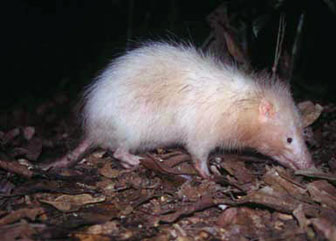Dinosaur extinction didn’t produce current mammal evolution
Dinosaur extinction didn’t produce current mammal evolution
mongabay.com
March 28, 2007
A new Nature study argues that the demise of dinosaurs did not fuel the rise of mammals.
Devising a new ‘tree of life’ for 4,500 species of mammals using molecular evolutionary trees, an international team of researchers challenges the prevailing hypothesis that a mass extinction of dinosaurs 65 million years ago played a major role in the diversification of mammals. The authors show “that many of the genetic ‘ancestors’ of the mammals we see around us today existed 85 million years ago, and survived the meteor impact that is thought to have killed the dinosaurs.”
“The previous evidence showed that we did see a die-off of the dinosaurs and an increase in the rise of the mammals roughly 65 million years ago,” said John Gittleman, Director of the University of Georgia Institute of Ecology and a co-author of the study. “But the fossil record, by its very nature, is patchy. We have found that when you fuse all of the molecular trees with the fossil evidence, the timing does not work. The preponderance of mammals really didn’t take off until 10 to 15 million years after the demise of the dinosaurs.”

The Moon rat (Echinosorex gymnurus, a cat-sized insectivore found in the rainforests of Borneo. Photo by Dr. Konstans Wells of the University of Ulm in Germany |
“The end result is that the mammals we know today are actually quite old and just flew under the radar of everything that was out there, be they dinosaurs or now other archaic’ mammals as well, for a lot longer than most people suspected,” said Olaf Bininda-Emonds, lead author of the study and currently a professor at the University of Jena, Germany. “This is just the first of many insights, if not surprises, about mammalian evolution to be mined with the help of the tree.”
The researchers found that after an initial “small pulse” of mammalian diversification immediately after the dinosaur extinction, most of new mammal species died out without leaving descendants. It took 10 to 15 million years after the dinosaurs vanished before modern mammal diversification really began to accelerate during the Eocene epoch, about 56 to 34 million years ago. Researchers aren’t sure of the reasons for the timing of the diversification, though they cite warmer temperatures and the evolution of flowering plants — which would have given mammals more food sources — as possible factors.
“Our research has shown that for the first 10 or 15 million years after the dinosaurs were wiped out, present day mammals kept a very low profile, while these other types of mammals were running the show,” said Andy Purvis, a Professor of Biology at Imperial College London. “It looks like a later bout of ‘global warming’ may have kick-started today’s diversity — not the death of the dinosaurs.”
“The big question now is what took the ancestors of modern mammals so long to diversify,” said Ross MacPhee, a curator in the Division of Vertebrate Zoology at the American Museum of Natural History. “It’s as though they came to the party after the dinosaurs left, but just hung around while all their distant relatives were having a good time. Evidently we know very little about the macroecological mechanisms that play out after mass extinctions.”
The researchers say their work may have implications for the man-made extinction event currently underway.
Dr adds: “Not only does this research show that the extinction of the dinosaurs did not cause the evolution of modern-day mammals, it also provides us with a wealth of other information,” Kate Jones from the Zoological Society of London. “Vitally, scientists will be able to use the research to look into the future and identify species that will be at risk of extinction. The benefit to global conservation will be incalculable.”
The team included researchers from the Zoological Society of London, American Museum of Natural History, the Royal Botanic Gardens, the National Evolutionary Synthesis Center, the University of British Columbia, the University of New South Wales, and the University of Georgia.
This article uses quotes from press materials released by the University of New South Wales, Imperial College London, and the University of Georgia














